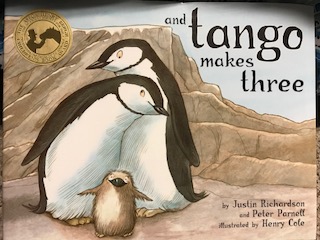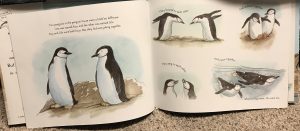
Title: And Tango Makes Three
Author: Justin Richardson and Peter Parnell
Illustrator: Henry Cole
Publisher: Simon & Schuster
Year: 2005
Number of Pages: 32
Tags: Animals, Award Book, Diversity, Family, Friendship, Non-fiction, Picture Book, K-1, 2-3, Taylor Krueger
Genre: Non-fiction Children’s Literature
Analysis: This book shows the story of two chinstrap penguins who live in a New York City zoo. These two male penguins, Roy and Silo, did everything together, and wherever one went the other followed. Roy and Silo were in love, but no matter how many nests they built they could not have an offspring. The penguin’s caretaker found an egg that needed caring, and brought it to Roy and Silo’s nest. Both penguins looked after the egg and then it hatched a beautiful baby penguin named Tango. From then on Silo and Roy raised Tango as being the first offspring to have two daddies, and they lived as one family.
The illustrations of this book do not have borders, which allows the reader to view the character’s actions from within. The reader is present in the illustrations rather than looking from afar. The images are either one large illustration or there are multiple smaller images showing a timeline of actions. These scattered images are integrated with the text to further enhance the plotline. The smaller illustrations are framed by light backgrounds in a circular shape. There is a very thin vanishing line of the  images, but the illustrations softly disappear to the white background. The images show great texture of the penguins and have detail that allows the reader to feel like they are looking into a window of their lives.
images, but the illustrations softly disappear to the white background. The images show great texture of the penguins and have detail that allows the reader to feel like they are looking into a window of their lives.
The colors used throughout the book are very light and soft; it makes the reader feel calm and content. The illustrator uses soft blues, yellows, tans, and blacks to enhance the characters of the story. The use of brighter colors are incorporated into parts of the book to show happiness and freedom of the characters.
There are many emotions that are shown through the structure of the facial expressions of the main characters, Silo and Roy. They are at times happy, confused, excited, and sad. Their emotions are depicted through the illustrations and further shown with the addition of the text. They are perceived to be disappointed when they cannot create an offspring, and then overjoyed when an egg is placed in their nest. The main characters are shown to be very large on the pages compared to some of the other penguins, which shows their confident self-image. The illustrations of the penguins share the constant theme shown throughout the book, which is the diversity of family. The relationship of the penguins represents same-sex parents, which is shown through the illustrations and text of the main characters. This relates to the current social issues surrounding the idea of same-sex marriage. This story is empowering for children and shows the love for diversity in family and relationships. The ideology of this book is very strong and speaks on important issues that are prevalent in today’s society.
This book is a representation of multimodal text because the words and illustrations interact to fill in the gaps of the reader. The illustrations further enhance the text, and are shown to be a visual representation of the words. The text explains the plot, and the illustrations amplify the words and allow the reader to visualize what is being said. The illustrations develop the setting of the zoo and the visualization of the characters, while the text creates the plot.
There is an author’s note at the end of the book that showcases the true story of Roy and Silo. This book is based off the real life penguins at Central Park Zoo. The reader can go there today and find this family swimming through the water at the zoo. The author’s note gave a more impactful meaning the story of Silo and Roy as they exist in the world, and allow the reader to realize the authenticity of the story.
